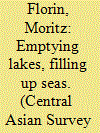|
|
|
Sort Order |
|
|
|
Items / Page
|
|
|
|
|
|
|
| Srl | Item |
| 1 |
ID:
165968


|
|
|
|
|
| Summary/Abstract |
In the late Soviet Union, large-scale projects such as the Toktogul Dam in the Kyrgyz Soviet Republic were promoted as emblems of the Soviet model of development in Asia. While Central Asian politicians and intellectuals usually tuned in to the enthusiasm, the construction also revealed different opinions about the precise direction and goals of Soviet development. Large-scale investments became focal points of political and intellectual debates; they not only helped bind the periphery closer to the Soviet centre, but also revealed the different economic, political and cultural priorities of the regional, republican and union-wide actors. The construction of dams and reservoirs eventually triggered conflicts between the republics and laid the foundation for an anti-colonial critique of the late Soviet state.
|
|
|
|
|
|
|
|
|
|
|
|
|
|
|
|
| 2 |
ID:
193579


|
|
|
|
|
| Summary/Abstract |
The Himalayan region is renowned as a powerhouse of Asia. Despite its abundant natural resources, youthful population, and strategic location between two rapidly developing Asian economies, the social and economic conditions in the Himalayan region, particularly in Nepal and Bhutan, have remained consistently underdeveloped. Various factors contribute to this, including climate change-induced disasters, political instability, strained bilateral relations between lower and upper riparian countries, and inadequate resource management. This article aims to address the existing research gap by exploring the energy potential of the Himalayan region and its viability for sustainable economic growth in the face of increasing global temperatures and climate-induced energy crises. The article asserts that, unless the region diversifies its energy sources to include other renewables, the Himalayan region (comprising Nepal, Bhutan, and the Indian Himalayan States-IHS) may not be able to serve as a stable hydro energy supplier to the South Asian region. This is due to inherent challenges and the strategic competition between India and China, both regionally and globally.
|
|
|
|
|
|
|
|
|
|
|
|
|
|
|
|
| 3 |
ID:
153173


|
|
|
|
|
| Publication |
London, Elsevier, 2014.
|
| Description |
xi, 376p.pbk
|
| Standard Number |
9780128010273
|
|
|
|
|
|
|
|
|
|
|
|
Copies: C:1/I:0,R:0,Q:0
Circulation
| Accession# | Call# | Current Location | Status | Policy | Location |
| 059079 | 333.79/TOW 059079 | Main | On Shelf | General | |
|
|
|
|
| 4 |
ID:
163753


|
|
|
|
|
| Summary/Abstract |
One of the most-studied issues regarding the role of natural resources in development is the so-called “resource curse”: the paradoxical (and contested) situation in which a state with abundant resources has low rates of economic growth per capita, high levels of income inequality, low levels of democracy, high gender inequality, and high levels of domestic and international conflicts surrounding resources. Although the term seems to imply that the curse can apply to all resources, most research by political scientists, as well as by economists and other social scientists, examines the role of oil and hard minerals and omits many resources, including renewable energy resources. We argue that many of the causal mechanisms behind the curse, when it does manifest, hold for water-abundant states which have sufficient resources to create large hydroelectric projects. Drawing on illustrative examples of hydroelectric projects around the world, we demonstrate sufficient, albeit preliminary, evidence that most aspects of the resource curse literature apply to hydroelectric projects, at least in some states, and thus suggest the curse literature should be expanded to include water-abundance. Additionally, we add a new factor—fluctuating fuel supply—which could be an important variable for other resources as well. We conclude with suggestions for developing a research agenda and discuss policies to reduce the negative effects of resource curse.
|
|
|
|
|
|
|
|
|
|
|
|
|
|
|
|
| 5 |
ID:
104130


|
|
|
|
|
| Publication |
2011.
|
| Summary/Abstract |
This article examines the energy security implications of the Sarawak Corridor of Renewable Energy in Malaysia (SCORE), a US$105 billion infrastructure development plan in Sarawak on the island of Borneo. SCORE aims to build a series of hydroelectric dams along a 320-kilometer corridor by 2030. The article begins by explaining the methodology utilized for its research interviews and site visits. It goes on to argue that energy security in Southeast Asia should consist of simultaneously improving the availability, affordability, efficiency and stewardship of energy services for end users. Availability involves diversifying the fuels and technologies in energy production and minimizing dependence on imports; affordability means providing electricity and fuel within the income range of most consumers; efficiency means improving the performance of equipment and lowering demand for energy; and stewardship is minimizing political, social, and environmental hazards associated with energy production and consumption. The paper next introduces the SCORE project before making an assessment utilizing the four criteria of energy security. While SCORE partially improves availability, we argue that it erodes aspects of affordability, efficiency and stewardship. Cost overruns and delays in financing will make the electricity from SCORE suitable only to industrial users, not the energy poor. SCORE is predicated on the assumption that electricity demand should grow greatly in the future rather than the idea that energy efficiency and demand side management programmes should attempt to reduce growth in demand for electricity. SCORE also has a pernicious set of social, environmental and political consequences.
|
|
|
|
|
|
|
|
|
|
|
|
|
|
|
|
| 6 |
ID:
126163


|
|
|
|
|
| Publication |
2013.
|
| Summary/Abstract |
Underinvestment, low levels of electricity access, natural disasters, topography and hydrology make Nepal's electricity crisis akin to 'peeling a pickle': difficult to pin down and hard to manage. Based primarily on the perceptions of a sample of experts, this article lays out a roadmap for how the 'pickle' of the Nepali electricity crisis can be peeled. Drawing on primary data collection from research interviews, the study offers a brief summary of the Nepali electricity and energy sectors. It then details six separate electricity challenges identified by respondents-topography and climate; political instability resulting from the aftermath of the Maoist insurgency; poverty and corruption; lack of financing and investment; constrained technological and human resources; and, finally, aid dependency and political manoeuvring. We conclude by calling on Nepali policymakers to invest in distributed generation, transmission upgrades, seasonal hydroelectric storage and industrial energy efficiency practices, and to introduce electricity tariff reforms, among other measures.
|
|
|
|
|
|
|
|
|
|
|
|
|
|
|
|
| 7 |
ID:
133042


|
|
|
|
|
| Publication |
2014.
|
| Summary/Abstract |
This paper examines whether initiatives to promote hydroelectricity consumption are likely to be effective by applying univariate and panel Lagrange Multiplier (LM) unit root tests to hydroelectricity consumption in 55 countries over the period 1965-2011. We find that for the panel, as well as about four-fifths of individual countries, that hydroelectricity consumption is stationary. This result implies that shocks to hydroelectricity consumption in most countries will only result in temporary deviations from the long-run growth path. An important consequence of this finding is that initiatives designed to have permanent positive effects on hydroelectricity consumption, such as large-scale dam construction, are unlikely to be effective in increasing the share of hydroelectricity, relative to consumption of fossil fuels.
|
|
|
|
|
|
|
|
|
|
|
|
|
|
|
|
|
|
|
|
|